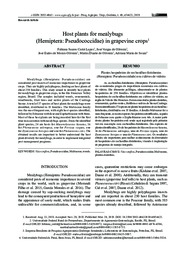Host plants for mealybugs (Hemiptera: Pseudococcidae) in grapevine crop.
Host plants for mealybugs (Hemiptera: Pseudococcidae) in grapevine crop.
Authorship: LOPES, F. S. C.; OLIVEIRA, J. V. de; OLIVEIRA, J. E. de M.; OLIVEIRA, M. D. de; SOUZA, A. M. de
Summary: Mealybugs (Hemiptera: Pseudococcidae) are considered pest insects of economic importance in grapevine crops. They are highly polyphagous, feeding on host plants of about 250 families. This study aimed to identify host plants for mealybugs in grapevinecrops, in the São Francisco Valley region, Brazil. The samples included weeds, ornamentals, windbreaks, fruit trees and native plants of the Caatinga biome. A total of 37 species of host plants for mealybugs were identified, distributed in 18 families. The Malvaceae family was the most frequent one, with eigth host species identified, followed by Fabaceae with four and Euphorbiaceae with three. Most of these host plants are being recorded here for the first time in association with mealybugs species. From the identified plant species, 24 are hosts for Maconelicoccus hirsutus, 16 for Phenacoccus solenopsis, one for Ferrisia virgata, one for Dysmicoccus brevipes and one for Planococcus citri. The obtained results are important to better understand the host plant diversity for mealybugs, in order to implement integrated pest management programs.
Publication year: 2019
Types of publication: Journal article
Unit: Embrapa Semi-arid Region
Keywords: Cochonilhas-farinhentas, Grapes, Inseto, Malvaceae, Percevejo, Planta Hospedeira, Plantas daninhas, Praga, Uva, Videira
Observation
Some of Embrapa's publications are published as ePub files. To read them, use or download one of the following free software options to your computer or mobile device. Android: Google Play Books; IOS: iBooks; Windows and Linux: Calibre.
Access other publications
Access the Agricultural Research Database (BDPA) to consult Embrapa's full library collection and records.
Visit Embrapa Bookstore to purchase books and other publications sold by Embrapa.

